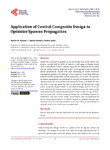Application of Central Composite Design to Optimize Spawns Propagation

View/
Date
2020Author
Kasina, Martin M
Koske, Joseph
Mutiso, John
Metadata
Show full item recordAbstract
Despite the increased recognition of the nutritional value of the Oyster mushroom, coupled with its ability to tolerate a wide range of climatic conditions, its production is still at infancy stage with low adoption rate in Kenya. The low uptake could be attributed to the cost of spawns or lack of skills for spawns preparations coupled with poor knowledge on oyster mushroom consumption benefits. The objective of this study was to optimize Pleurotus ostreatus (Oyster mushroom) spawns production. To achieve the objective, the spawns propagation was optimized by varying the temperature level, sterilization time and culture media concentration in order to establish the feasible levels which minimized the days of mycelium full development using central composite designs. Based on the study findings, 26.29˚C, 17.36 minutes and 60.95 g/L of temperature level, sterilization time and culture media concentration levels respectively minimized the days to full coverage of mycelium in a petri dish. Central composite designs for controlling temperature, sterilization time and culture media concentration were recommended for spawns maximum production. A further research on multiple response optimizations aimed at achieving resistance to bacterial diseases and yield by varying the strain in the culture were recommended.
